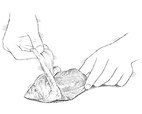Why this recipe works:
For our take on the elegant white wine version of coq au vin, starting
with a whole chicken and then breaking it down ourselves was a must, not
only to obtain evenly sized parts that would cook at the same rate but
also so that we could use the back and wings to enrich the sauce. The
fond created from browning the chicken skin was also essential for
flavor but required browning the chicken parts in batches. Plus, the
skin turned flabby during braising. The solution? Removing the skin from
the meat, browning it in one batch, and then discarding it before
serving. Adding about three-quarters of a bottle of dry Riesling along
with a cup of water produced a sauce that was nuanced and balanced.
Finally, we finished the sauce with crème fraîche for just the right
silkiness and body.
Serves 4 to 6
A dry Riesling is the best wine for this recipe, but a Sauvignon Blanc or Chablis will also work. Avoid a heavily oaked wine such as Chardonnay. Serve the stew with egg noodles or mashed potatoes.Ingredients
- 1 (4- to 5-pound) whole chicken, cut into 8 pieces (4 breast pieces, 2 drumsticks, 2 thighs), wings and back reserved
- Salt and pepper
- 2 slices bacon, chopped
- 3 shallots, chopped
- 2 carrots, peeled and chopped coarse
- 2 celery ribs, chopped coarse
- 4 garlic cloves, lightly crushed and peeled
- 3 tablespoons all-purpose flour
- 2 1/2 cups dry Riesling
- 1 cup water
- 2 bay leaves
- 6 sprigs fresh parsley, plus 2 teaspoons minced
- 6 sprigs fresh thyme
- 1 pound white mushrooms, trimmed and halved if small or quartered if large
- 1/4 cup crème fraîche
Instructions
-
1. Remove skin from chicken breast pieces, drumsticks, and thighs and set aside. Sprinkle both sides of chicken pieces with 1 1/4 teaspoons salt and 1/2 teaspoon pepper; set aside. Cook bacon in large Dutch oven over medium-low heat, stirring occasionally, until beginning to render, 2 to 4 minutes. Add chicken skin, back, and wings to pot; increase heat to medium; and cook, stirring frequently, until bacon is browned, skin is rendered, and chicken back and wings are browned on all sides, 10 to 12 minutes. Remove pot from heat and carefully transfer 2 tablespoons fat to small bowl and set aside.
2. Return pot to medium heat. Add shallots, carrots, celery, and garlic and cook, stirring occasionally, until vegetables are softened, 4 to 6 minutes. Add flour and cook, stirring constantly, until no dry flour remains, about 30 seconds. Slowly add wine, scraping up any browned bits. Increase heat to high and simmer until mixture is slightly thickened, about 2 minutes. Stir in water, bay leaves, parsley sprigs, and thyme and bring to simmer. Place chicken pieces in even layer in pot, reduce heat to low, cover, and cook until breasts register 160 degrees and thighs and legs register 175 degrees, 25 to 30 minutes, stirring halfway through cooking. Transfer chicken pieces to plate as they come up to temperature.
3. Discard back and wings. Strain cooking liquid through fine-mesh strainer set over large bowl, pressing on solids to extract as much liquid as possible; discard solids. Let cooking liquid settle for 10 minutes. Using wide shallow spoon, skim fat from surface and discard.
4. While liquid settles, return pot to medium heat and add reserved fat, mushrooms, and 1/4 teaspoon salt; cook, stirring occasionally, until lightly browned, 8 to 10 minutes.
5. Return liquid to pot and bring to boil. Simmer briskly, stirring occasionally, until sauce is thickened to consistency of heavy cream, 4 to 6 minutes. Reduce heat to medium-low and stir in crème fraîche and minced parsley. Return chicken to pot along with any accumulated juices, cover, and cook until just heated through, 5 to 8 minutes. Season with salt and pepper to taste, and serve.
Technique
Picking the Right White
Shopping for Riesling can be tricky. For this recipe, don’t worry about the wine’s origin, but do make sure to get a drier style of Riesling rather than a sugary one. Since this information isn’t always clearly indicated on labels, here are a few tips:
1. Austrian Rieslings are usually a safe bet; most are dry.
2. On bottles of German Riesling, look for the word “trocken,” which means dry.
3. On the back label of some Rieslings, you’ll find a sliding scale indicating where the wine falls on the dry-sweet spectrum. Make sure it falls on the drier half.
4. Look for Riesling that is 11 percent alcohol by volume or above. The higher the alcohol level, the drier the wine.
5. Alternately, we found that Sauvignon Blanc or Chablis will work. Avoid oaky Chardonnays, which can turn bitter when reduced.
Technique
Chicken Skin: Turning a Liability into an Asset
The flabby chicken skin produced by braising is always unappealing. But the crisp, well-browned skin on a great roast chicken can be the best part of the dish. That’s because when skin is sautéed or roasted, its unsaturated fats oxidize, producing deeply flavorful compounds. At the same time, once the skin reaches temperatures over 300 degrees, amino acids, the building blocks of the skin’s proteins, react with some of its carbohydrates to set off the Maillard reaction, which produces browning and hundreds of additional complex flavor compounds.
To capitalize on these assets and avoid flabby texture, we treat the skin like a stand-alone ingredient, removing it from the cut-up chicken and then browning it in the pot along with the bacon and chicken wings and back. Leaving the skin in the pot throughout the simmer and only straining it out at the end of cooking ensures that all its flavors dissolve into the sauce.

DON'T DITCH THE SKIN: We brown the skin along with the back and wings to extract flavor and then simmer it in
the sauce before discarding it.





















0 comentarios:
Publicar un comentario